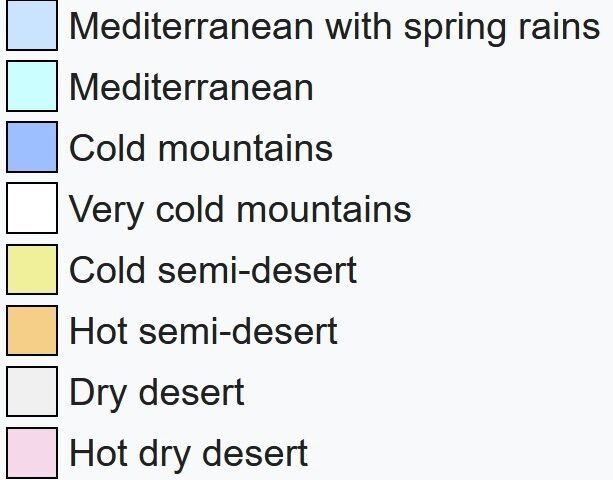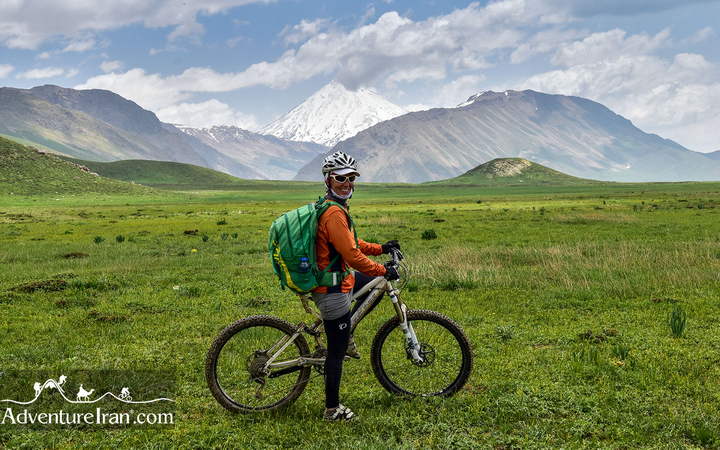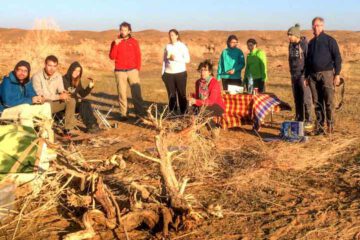Climate and Weather for Travelling to Iran
One of the elements that helps you to have the Best Iran Tour is having good knowledge of the climate and weather for travel to Iran. Iran is a large and vast country; it has a very varied climate with different weather systems covering an area of 1,648,195 km2 (636,372 sq miles). To compare the size of the country, Iran is about 5 times bigger than Italy and about 4.4 times bigger than Japan. Geographically, Iran is located west of Asia and lies between the southern part of the Caspian Sea and north of the Persian Gulf and Makran Sea, (Gulf of Oman). Iran has different types of weather systems in each region with a variable climate.
In general, Iran is an arid country compared to east Asian countries but in the west and north, (Alborz and Zagros Mountain ranges), the rains are more abundant than in the east and south, (Dasht-e Kavir & Lut Desert regions). The rainiest area in Iran is along the Caspian Sea coast which is the greenest part of the country with enormous jungles in the various regions. The famous Hyrcanian forest, (UNESCO), is also located in the Caspian Sea region.
The north and west of Iran have exceptionally cold winters with heavy snowfall and freezing temperatures while in the east and south in the Iran plateau, the climate is continental and arid. The weather along the Caspian Sea coast is mild and quite wet while along the south coast, the Persian Gulf, and Oman Sea region, it is hot.
Seasons and their weather based Activities
Depending on which season, even which month and the region you would like to visit, we’d like to emphasize the weather varies dramatically from the north of the country, “the Alborz mountains and the Caspian Sea”, compared to the south, “the Persian Gulf and Makran Sea (Oman Sea)”. For example, during late autumn to the end of winter, the temperature is very cold in the high and mountainous areas. Then it would be opportune to travel to the desert region or south of the country.
In general, the ideal weather and temperature of the country are divided into two periods of the year; spring and autumn. Most visitors will find these two seasons is the perfect time to travel to Iran. During these seasons, the temperature is pleasantly warm, especially for those who would like to explore the main tourist sites by joining “IRAN CLASSIC ROUTE”. In order to have a better and more complete picture of Iran’s climate throughout the year, we have described below each season and what activity you can do in the one you choose.
1-Spring season (21 March – 21 June)
Spring is an ideal time to travel to Iran due to climate and weather. It starts on 21 March which is the first day of the Persian New Year in the Iranian Calendar. Everyone knows spring is the end of winter and the beginning of good weather and temperature but the change of the season from winter to spring does not happen on the first day of spring. In such a massive country with its varied climate, spring starts first from the south of the country and then goes gradually up towards the north.
If you are traveling from the southern part of Iran from the beginning of March, you will notice the arrival of spring from the flowers in bloom and the trees in bud. In the central part of Iran, however, temperatures are still particularly cold and, in some parts of the mountain region, the temperature is freezing. In the Alborz Ski Region, people are still skiing in March.
We rode our bicycles in early March 2017 for two months starting from the Persian Gulf towards the Caspian Sea. During this trip, we observed what exactly happens with the change of seasons by cycling from winter to spring in various parts of the country. At the end of April, we finished our very enjoyable and memorable cycling trip tremendously and were delighted to still be able to see snow at the top of the Alborz mountains.
Many websites, or Iran guide books, written in different languages, mention Iran’s high season is spring. With the above example of our Coast-to-Coast cycling trip, you now have an idea of what to expect. The tourist season, in general, starts at the beginning of March when our first visitors arrive who will travel to Iran’s major urban tourist destinations like Shiraz, Esfahan, Yazd, Kashan, and Tehran.
In some tourist cities, it may be a little cool during the night but the day temperature for visiting the main UNESCO sites is perfect. It may rain sometimes but the temperature is pleasant for visiting the cities. This ideal climate stretches till the end of April although this high season continues till May.
Many travelers prefer to combine their trip with other destinations such as those located in the mountain regions. To explore the northern parts of the country, the month of May is an excellent time to travel to the Alborz and Zagros mountains for this type of trip especially when you would like to include hiking or mountain biking in the north or west of the country. For those who would like to have more challenging activities like long mountain trekking and spending the nights camping in the mountains, June is a spectacular month for this.
The weather for adventure activities in the mountain regions and most of Iran’s national parks is more stable from June. The possibility of rain and snow in May is less and you may have a better temperature during the night. The only and most important point you should be aware of when arranging your travel is that the longest holiday of the year happens during (Nowruz), Iranian New Year, and sometimes lasts about 20 days. You will understand the implications very well especially when you travel through the main tourist cities.

2-Summer season (22 June – 22 September)
Summer, called Iran’s low season, needs a thorough explanation as it will open another door for yet another experience. In the summer season, which is from mid-June till mid-September, the weather is unpleasantly hot for traveling to urban destinations located mostly in central Iran. The temperatures inside the major tourist cities can be exceedingly high, but they are not like the humid, hot, and sticky season in south-east Asia. There aren’t mosquitos or other insects to annoy you.
For adventurous travelers, the summer season offers numerous opportunities to have an active holiday. Iran has many mountains above 4000m which are possible to ascend from June to September. For hikers who are thinking about high peaks, the ascent season is only during the summertime. For such a high-altitude mountain like MT Damavand, (5610m), being the highest volcanic mountain in Asia, the best ascent time is the summer. MT Alamkuh, (4850m), Iran’s second-highest mountain, and the Volcano mount of Sabalan, (4811 m), the third-highest are important mountains in this country. It’s like a dream come true for many travelers who will experience the hike of a lifetime.
Among those travelers who are coming for the high peaks, there are a lot of long trails in Iran’s many mountains which are doable during the summertime. A couple of these hiking trails pass through mountains with an altitude between 3000-4000 m. During the winter season, the route is covered by snow, making it impossible for mules, who normally carry baggage and camping gear, to cross the area.
Mountain Biking is yet another worthwhile activity to experience in Iran. Traveling by bicycle is not only an active holiday in Iran but it’s a way to connect and get to know the local people who are not only friendly but very hospitable too. There is an abundance of lush green mountain regions with pleasant weather in the summer. These regions are perfect for cyclists who would like to ride through amazing landscapes and unknown villages. The “Tehran to the Caspian Sea Mountain Biking Trail” which passes through Dena national park, high mountains, rural areas, the Hyrcanian forest, and ends up at the coast of the Caspian Sea is an excellent example of mountain biking during the summertime. This type of trail is extremely cold with the terrain covered by snow in the winter. The road is also mostly muddy due to heavy rain during spring and autumn.
Another special highlight of Iran is the nomadic tribes that traditionally practice stockbreeding. they do many different acts based on Iran’s weather. During the cold season, they are at a lower altitude. In the hot season, they migrate with their sheep, goats, and dogs, along with their whole family, to the highlands for their seasonal herding. Depending on what region of the country they are in, they start their move from mid-spring till the end of summer. The weather and climate are ideal for animals in these regions with their rich green pastures. It’s a marvelous idea to hike through their camping region to observe their lifestyle and recognize the different tribes.
We also created various treks for the summer in the Alborz and Zagros Mountains. The Highlands of Talesh in Gilan and Azerbaijan provinces, located west of the Alborz mountains and the Bakhtiari nomadic trail in Chaharmahal and Bakhtiari Province in the middle of the Alborz-mountain range, are two examples of these treks. The number of Persian nomadic tribes who herd customarily decreases year by year. They will be the last generation who will totally disappear in the coming years.
It can be an amazing experience for adventurous people to travel to the south of Iran along the Persian Gulf and Makran Sea, (Oman Sea), during the hot and humid summer weather. Swimming in the sea in the ‘off the beaten track part of Iran’, and exploring villages surrounded by palm trees is one of the most exciting and invigorating experiences you could have here.
Apart from the above activities, if you are a fan of the cultural and historical parts of Iran and prefer to have your holiday during the summer, (but not in the hot regions), we advise you to travel to the northwest and some parts of the west. If you pay attention to Iran’s UNESCO sites on the map, you will notice one-third of the total of Iran’s UNESCO heritage sites are located in the northwest and west of the country.
Visiting these sites will take up at least two weeks of your holiday. In addition, if you are also a fan of off the beaten track destinations, and would like to have perfect weather, we highly recommend you focus only on the northwest of Iran for a two weeks journey. It’s then possible to visit the three Azari regions which are in the three provinces of East Azarbaijan, West Azarbaijan, and Ardabil.

3-Autumn season (23 September-21 December)
In the autumn, the general season for cultural and historical visitors begins again. Depending on the region, the glorious weather of autumn starts, and the hot temperatures of summer are on the way out. At the beginning of September, the weather is going to change in northwest Iran. Also, in the northern slopes of the Alborz Mountain range, (the southern region of the Caspian Sea), you will get a lot of rain at the beginning of September with the temperature dropping accordingly. In the Iran plateau and central Iran, you can feel this cool weather as you near the end of the month. In many Iranian guide books or blogs on Iran’s travel websites, it is suggested that the perfect season is from September till November. However, if your interest is to visit one of the main Iranian highlights, (CLASSIC IRAN), the best autumn months to do so are October and November. This is because there are far fewer local visitors at this time than in the spring as schools open on 22nd September.
One of the main highlights of the country are the deserts which have the most visitors after Iran’s cultural sites. The climate varies according to the area but, in general, autumn is the season for having countless types of activities in the Dasht-e Kavir and Lut deserts. The excellent autumn weather starts in September in the northern part of the deserts like Maranjab and Kavir National Park, located south of Tehran province. This particularly agreeable temperature lasts till November. The other deserts season starts in October like Varzaneh, Mesr, and Farhzad which are in the center of Dasht-e Kavir Desert. November has the best temperature, between 20-30°C, in Dash-e Kavir which is perfect for trekking or cycling.

The other important desert is the huge Dasht-e Lut located in the southeast of Iran and registered in the list of UNESCO Natural World Heritage sites in 2016. Lut desert is hotter than that of Dasht-e Kavir. Gandom Berian is a location in the Lut which is the hottest place on the planet. The best season to have favorable weather for traveling to Lut starts later than in Dasht-e Kavir, by beginning around November and finishing in early March. The rest of the year is too hot to travel. Sometimes the difference between the day and night temperature is about 20-25 °C. You can expect to have a cold night in the desert. Apart from being inside the desert, visiting the small towns and villages around them is a must for travelers who like to enjoy off the beaten track destinations. South Khorasan Province, east of Dasht-e Kavir and north of Dasht-e Lut has so many attractions which are not mentioned in any travel guide book. You should visit them during autumn.
As well as desert adventures, mountain trekking and mountain biking in autumn are the third kind of trips you can enjoy. If you prefer to have a short trip, there are numerous treks and trails from moderate up to challenging and strenuous levels of difficulty around the capital. These are perfect for trekkers and cyclists. The Central Alborz mountains and Alborz Ski Region are excellent examples of such trips. In addition, if you would like to try a forest area, there are so many options in the Caspian region where you will also marvel at the splendid variety of the very majestic and colorful trees in the autumn.
There are a few famous national parks and protected areas that are just right for traveling in autumn. Touran, Golestan, and Jahan Nama are the ultimate experience for the adventurous traveler.
If this is your first visit to Iran and you are traveling during autumn, it’s possible to combine your cultural holiday with one of the above activities. This will make it the unforgettable trip of a lifetime.
Below are a couple of Adventure Iran’s multi-activity tours which are unsurpassable during autumn.
Iran Multi Activity Holiday
Best of Iran and hiking through Zagros Mountains
Hiking in Alborz Mountains and Maranjab Desert Trekking

4-Winter season (22 December-20 March)
In winter, from mid-December to mid-February, most of Iran’s provinces located above 1000m can get extremely cold. This is the season for winter activities. Alborz Ski region which is in the north of Tehran has the best ski resorts that operate from December to March. As well as skiing in the piste, there is an abundance of slopes around the piste which provide you with good powder skiing. There are a few mountains around the ski resorts which are also great for backcountry skiing. For those who do Ski Touring, the end of winter and the beginning of spring is the best time to come to have an absolutely thrilling adventure.
Along with the above activities, winter is a perfect time for sea activities around the south coast of Iran. If you are interested in traveling to off the beaten path destinations, you should travel to the south which has pleasing temperatures in the winter. The approximate 2000 km length of the coast starts from Abadan in the southwest of the country to the border with Iraq stretching all the way to the Pakistan border in the southeast. There are so many untraveled destinations. In the Persian Gulf, there are a few famous islands that are home to many backpackers who have come to escape from the cold winter to hang around the beach and enjoy the warm weather. There are a couple of dive centers on Kish island, Chabahr port in Baluchistan, and Qeshm island.

In addition, one of the most ideal destinations in winter is Sistan and Baluchistan province. This region is located in the southeast of the country and offers a multitude of activities and experiences. Even for us, local Iranians, this region is unusual. The people here are totally different. They speak the Baluchi language, wear traditional clothes and eat traditional food. This region is the one with the most hospitable people. For those of you who are interested in photography, this is the place to be to capture the particular lifestyle and beautiful landscape. It’s the largest province in Iran with a temperature between 25-30 °C during the winter.
Another destination is the Lut desert that we also offer at the end of autumn. If you are traveling during winter and you haven’t visited it, the natural UNESCO site of Dasht-e Lut should definitely be on your list. There are two important entrances to enter Lut, one is from Kerman and the other from Zahedan city.


















Comments